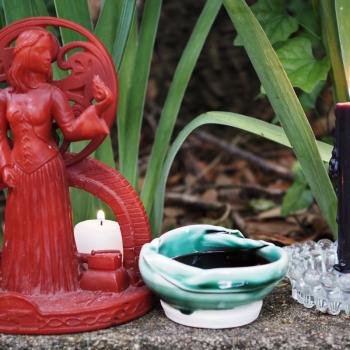When Wicca first emerged into the public eye in the 1950s, it was strictly a initiatory mystery religion. If you wanted to be a Witch, you needed to be initiated by Gerald Gardner himself, or by someone who had been given an initiation by him. When other traditions emerged, Alexandrian, 1734, the ethos of initiation by an already initiated High Priest or Priestess remained intact. In those early years many “traditional” Witches took a dim view of “bootstrap” attempts to start new traditions, and the notion of self-initiation. Author and Gardnerian elder Raymond Buckland was initially scornful of such groups, which he felt were harming the Craft, as documented in Chas Clifton’s “Her Hidden Children: The Rise of Wicca and Paganism in America.”
“It says much for the success of Gerald Gardner in obtaining recognition for the Craft as a religion, for its imitators are those who, unable to gain access to a coven, have decided to start their own. These do-it-yourself “witches” would, on the face of it, seem harmless but on closer scrutiny are not so. They are causing considerable confusion to others who, seeking the true, get caught up in the false… These “covens” [in both Britain and the United States] spreading like chicken-pox have no association with “the Craft.” Why do people start such “covens”? Why not wait and search? For some it is just that they have no patience. They feel so strongly for the Craft that they must participate in some way. By the time they eventually do come in contact with the true Craft it is too late. They are by then so set in their own rites and, unfortunately, have other whom they have led along, they they cannot back down. Some, however, are merely in search of fame and fortune.”
Buckland’s view, written circa 1970 and shared by many other Elders, would change dramatically by 1974 when he introduced his own tradition of Seax-Wicca, one that included the assertion that self-initiation could be valid (a growing consensus among many prominent modern Pagans and Wiccans). Between the introduction of feminist Goddess-traditions, the emergence of eclectic Wiccan traditions like the New Reformed Orthodox Order of the Golden Dawn, and the shifting attitudes of Traditional elders like Buckland and Doreen Valiente, the ground on the issue of self-initiation and solitary practice had moved considerably. That said, Witchcraft traditions, and the coven structure, whether old or newly created, was still the primary vehicle for growing Wicca despite a rising number of self-initiated solitary Wiccans. Then, in the late 1980s, something, someone, happened.
That something was the 1989 publication of Scott Cunningham’s “Wicca: A Guide for the Solitary Practitioner,” a book that literally introduced a new generation to Wicca, and helped change the face of modern Paganism.
To say the response to this book was immense is to do it a disservice. It has sold over 400,000 copies (by the year 2000), and is still in print today (by contrast, Starhawk’s “The Spiral Dance,” published ten years earlier, sold around 350,000 copies by 2000). That scale is important to note in a publishing industry that usually sees sales in the low thousands for many titles. Cunningham’s book tapped into a growing need within the Wiccan/Witchcraft community, one for a simple guide for those who couldn’t find a coven, or couldn’t find a one that they felt comfortable with. While the ethos of self-initiation had become normalized by the 1980s, most books were still aimed at groups, and many felt frustrated in learning to piece together a practice that worked for them. Cunningham’s books happened at just the right place and time, and helped fuel the coming boom of Wicca (and modern Paganism) in the 1990s.
Now, author and magician Donald Michael Kraig has published a short ebook on the life of Scott Cunningham, whom he lived with for six years, and counted as a close friend. Entitled “The Magical Life of Scott Cunningham,” it promises to give us a glimpse into the man who changed the face of religious Witchcraft.
“Before Scott, Wicca was primarily passed on within the coven structure. In order to become a Wiccan you had to find a coven and study with them. If you couldn’t find a coven, or there was no coven near you, well, you were just out of luck. Scott’s book, Wicca: A Guide for the Solitary Practitioner, gave instructions on how any individual could come to love the Goddess and become a Wiccan. In the years that followed, Solitary Wicca became the primary way most people entered the Craft. Scott didn’t denigrate the coven structure, he simply gave an alternate approach to Wicca and made it available to all. It’s rare that the actions of one person change the world, and even more rare that such changes can be seen. Scott Cunningham was such a person. […] In the book I also share some of our experiences together so you will learn not just where he was born and what he did, but what he was like. I hope you get an idea of who Scott Cunningham was. Many of the anecdotes and stories have never been published before. The stories and his magical methods pepper chapters on his theories and methods of performing natural magic, his approach to The Goddess and Wicca, and his love for the land, people and magic of Hawaii.”
Cunningham tragically died in 1993 from an AIDS-related illness, a mere four years after his breakthrough success, but long enough to start to see how much his work impacted the community of which he was a part. Too little has been published about Cunningham, and Kraig’s short work, available for only $1.99 on Amazon, is a needed corrective. One that will no doubt be cited by authors and scholars for years to come. I’ve already purchased my copy, and look forward to reading it.
Cunningham’s work has changed us, and grown us, into what we are today. He not only changed Wicca, but also changed the larger ethos of the Pagan community itself. Today a vast majority of Pagans are solitary in their practice, and a slim majority describe themselves as eclectic. Books like “Wicca: A Guide for the Solitary Practitioner” provided an affirmation that this was acceptable, healthy, and normal. In an era of social networking on the Internet, the utility of Cunningham’s work is ever-more apparent. Many of us are connected with hundreds, even thousands, of our fellow Pagans, but we are still solitary practitioners when it comes time to light the candles and honor the gods.















